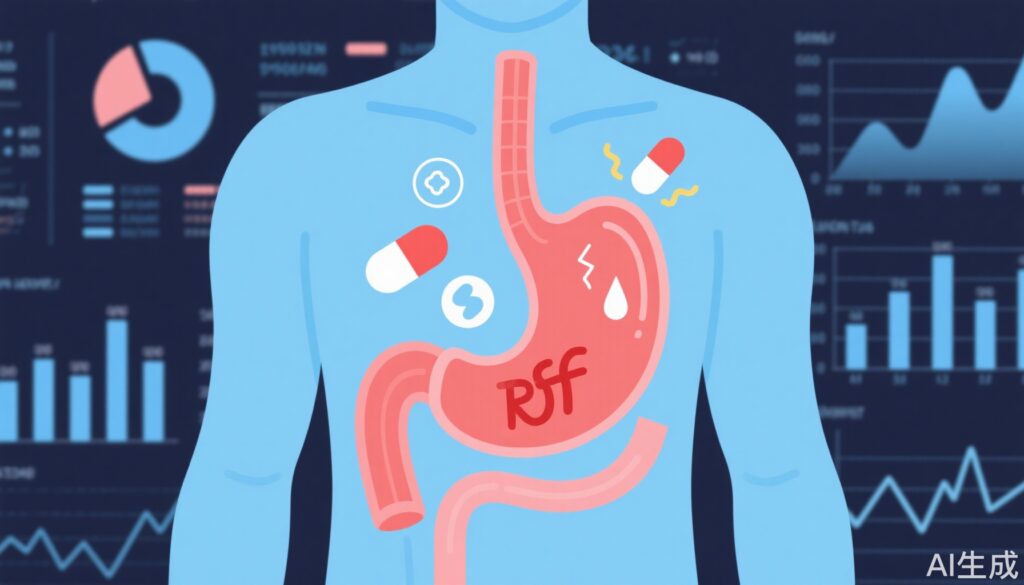Highlights
- GLP-1 receptor agonists (GLP-1 RAs) are associated with a 27% increased relative risk of incident gastroesophageal reflux disease (GERD) compared to SGLT-2 inhibitors in patients with type 2 diabetes.
- The absolute risk increase for GERD was modest, at 0.7 per 100 patients over three years.
- GLP-1 RA use was also linked to a higher risk of GERD complications, though the absolute risk increase was small (0.8 per 1000 patients).
- Clinical vigilance for GERD symptoms is warranted in type 2 diabetes patients treated with GLP-1 RAs.
Clinical Background and Disease Burden
Gastroesophageal reflux disease (GERD) is a prevalent gastrointestinal disorder, characterized by troublesome symptoms such as heartburn and regurgitation, and is associated with risks of esophagitis, Barrett’s esophagus, and even esophageal adenocarcinoma. Patients with type 2 diabetes (T2D) are already at increased risk for gastrointestinal motility disorders, including delayed gastric emptying (gastroparesis), which can further predispose to GERD. With the expanding use of GLP-1 receptor agonists for both glycemic control and weight reduction in T2D, understanding their gastrointestinal safety profile is critical.
GLP-1 RAs, such as liraglutide, semaglutide, and dulaglutide, are widely recommended for their cardiometabolic benefits. However, their known mechanism of delayed gastric emptying—an effect beneficial for satiety—raises concerns about potentiating GERD risk. Until recently, direct comparative evidence between GLP-1 RAs and other antidiabetic agents, specifically regarding GERD risk, has been limited.
Research Methodology
This study by Noh et al. (Ann Intern Med. 2025 Jul 15) leveraged the U.K. Clinical Practice Research Datalink, a comprehensive national database of electronic health records, to emulate a target trial design. The investigators conducted an active-comparator new-user cohort study, reducing biases inherent in retrospective observational analyses and enhancing causal inference.
Population: Adults (≥18 years) with T2D who initiated either a GLP-1 RA or a sodium-glucose cotransporter-2 (SGLT-2) inhibitor between January 2013 and December 2021 were included. The final sample comprised 24,708 new users of GLP-1 RAs and 89,096 new users of SGLT-2 inhibitors, with a median follow-up of 3 years (until March 2022).
Interventions and Comparators: The primary comparison was between GLP-1 RA and SGLT-2 inhibitor initiation. SGLT-2 inhibitors were chosen as an active comparator as they also represent second- or third-line antihyperglycemic therapy and have a neutral or possibly beneficial gastrointestinal safety profile.
Endpoints: The primary outcome was incident GERD, identified via diagnostic codes. The secondary outcome was the occurrence of GERD complications (e.g., erosive esophagitis, Barrett’s esophagus, esophageal stricture).
Statistical Approach: Risk ratios (RRs) and risk differences (RDs) for three-year outcomes were estimated using propensity score fine stratification to control for confounding by indication and baseline covariates.
Key Findings
Over three years, incident GERD was observed more frequently among GLP-1 RA users compared to SGLT-2 inhibitor users:
- Incident GERD: RR 1.27 (95% CI, 1.14–1.42); RD 0.7 per 100 patients
- GERD Complications: RR 1.55 (95% CI, 1.12–2.29); RD 0.8 per 1000 patients
This suggests that for every 100 patients treated with a GLP-1 RA instead of an SGLT-2 inhibitor, there would be approximately 0.7 additional cases of GERD over three years. The absolute risk increase for GERD complications, while statistically significant, was small.
The findings were robust across sensitivity analyses, including adjustment for multiple potential confounders. However, the authors noted that residual confounding, especially due to unmeasured dietary and lifestyle factors, cannot be entirely excluded.
Mechanistic Insights and Biological Plausibility
The observed association is biologically plausible. GLP-1 RAs are known to slow gastric emptying, a mechanism that increases gastric volume and pressure, potentially promoting reflux of gastric contents into the esophagus. This pharmacologic effect is a double-edged sword: while it aids in glycemic and weight control, it may predispose susceptible individuals to GERD.
In contrast, SGLT-2 inhibitors do not significantly affect gastric motility or intragastric pressure, making them an appropriate active comparator for this analysis.
Expert Commentary
Current American Diabetes Association (ADA) and European Association for the Study of Diabetes (EASD) guidelines recommend GLP-1 RAs as a preferred option for T2D patients with cardiovascular or renal comorbidities, and for obesity management. However, this study’s findings highlight the importance of individualized care and symptom monitoring:
“While the cardiometabolic benefits of GLP-1 RAs are compelling, clinicians should be attentive to gastrointestinal side effects, including GERD, particularly in patients with pre-existing reflux symptoms or other risk factors for esophageal complications.” (Expert opinion, paraphrased from ADA Standards of Care 2024)
Controversies and Limitations
Despite the strengths of a large, representative cohort and robust methodology, several limitations warrant consideration:
- Residual Confounding: The lack of data on dietary habits, body position during sleep, smoking, and alcohol use—all known GERD risk factors—may bias results.
- Diagnosis Coding: Reliance on EHR diagnostic codes may underestimate GERD incidence, as mild cases might not be recorded.
- Generalizability: The study population was U.K.-based; results may differ in populations with different GERD prevalence or prescribing patterns.
- Absolute Risk: The absolute risk increases, while statistically significant, are small. Clinical decision-making should weigh these risks against the proven benefits of GLP-1 RAs.
Conclusion
This population-based cohort study provides new evidence that GLP-1 receptor agonists are associated with a modestly increased risk of GERD and its complications compared to SGLT-2 inhibitors in patients with type 2 diabetes. Given the widespread and growing use of GLP-1 RAs, clinicians should proactively inquire about reflux symptoms and consider preventive strategies, especially in high-risk individuals. While these findings should not preclude GLP-1 RA use, they underscore the need for a tailored, patient-centered approach and further confirmatory research.
References
1. Noh Y, Yin H, Yu OHY, Bitton A, Azoulay L. Glucagon-Like Peptide-1 Receptor Agonists and Risk for Gastroesophageal Reflux Disease in Patients With Type 2 Diabetes: A Population-Based Cohort Study. Ann Intern Med. 2025 Jul 15. doi: 10.7326/ANNALS-24-03420. Epub ahead of print. PMID: 40658955.
2. American Diabetes Association. Standards of Medical Care in Diabetes—2024. Diabetes Care 2024;47(Suppl 1):S1–S350.
3. Vilsbøll T, Knop FK. Glucagon-like peptide-1 receptor agonists for the treatment of type 2 diabetes: clinical use and future directions. Lancet Diabetes Endocrinol. 2014;2(4):305–314.
4. Vakil N, van Zanten SV, Kahrilas P, Dent J, Jones R. The Montreal definition and classification of gastroesophageal reflux disease: A global evidence-based consensus. Am J Gastroenterol. 2006;101(8):1900–1920.



